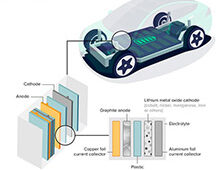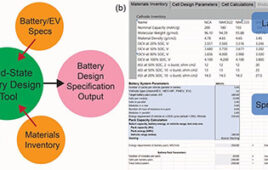Researchers at Rice University and the Université catholique
de Louvain, Belgium, have developed a way to make flexible components for
rechargeable lithium-ion (Li) batteries from discarded silicon.
The Rice laboratory of materials scientist Pulickel Ajayan
created forests of nanowires from high-value but hard-to-recycle silicon. Silicon
absorbs 10 times more lithium than the carbon commonly used in Li batteries,
but because it expands and contracts as it charges and discharges, it breaks
down quickly.
The Ajayan laboratory reports in the Proceedings of the National Academy of Science on its technique to
make carefully arrayed nanowires encased in electrically conducting copper and
ion-conducting polymer electrolyte into an anode. The material gives nanowires
the space to grow and shrink as needed, which prolongs their usefulness. The
electrolyte also serves as an efficient spacer between the anode and cathode.
Transforming waste into batteries should be a scalable
process, says Ajayan, Rice’s M. and Mary Greenwood Anderson Professor in
Mechanical Engineering and Materials Science and of chemistry. The researchers
hope their devices are a step toward a new generation of flexible, efficient,
inexpensive batteries that can conform to any shape.
Co-lead authors Arava Leela Mohana Reddy, a Rice research
scientist, and Alexandru Vlad, a former research associate at Rice and now a
postdoctoral researcher at the Université catholique de Louvain, were able to
pull multiple layers of the anode/electrolyte composite from a single discarded
wafer. Samples of the material made at Rice look like strips of white tape or
bandages.
They used an established process, colloidal nanosphere
lithography, to make a silicon corrosion mask by spreading polystyrene beads
suspended in liquid onto a silicon wafer. The beads on the wafer self-assembled
into a hexagonal grid—and stayed put when shrunken chemically. A thin layer of
gold was sprayed on and the polystyrene removed, which left a fine gold mask
with evenly spaced holes on top of the wafer. “We could do this on wafers the
size of a pizza in no time,” Vlad says.
|
The mask was used in metal-assisted chemical etching, in
which the silicon dissolved where it touched the metal. Over time in a chemical
bath, the metal catalyst would sink into the silicon and leave millions of
evenly spaced nanowires, 50 to 70 microns long, poking through the holes.
The researchers deposited a thin layer of copper on the
nanowires to improve their ability to absorb lithium and then infused the array
with an electrolyte that not only transported ions to the nanowires but also
served as a separator between the anode and a later-applied cathode.
“Etching is not a new process,” Reddy says. “But the
bottleneck for battery applications had always been taking nanowires off the
silicon wafer because pure, free-standing nanowires quickly crumble.” The
electrolyte engulfs the nanowire array in a flexible matrix and facilitates its
easy removal. “We just touch it with the razor blade and it peels right off,”
he says. The mask is left on the unperturbed wafer to etch a new anode.
When combined with a spray-on current collector on one side
and a cathode and current collector on the other, the resulting battery showed
promise as it delivered 150 milliamp hours per gram with little decay over 50
charge/discharge cycles. The researchers are working to enhance those qualities
and testing the anodes in standard battery configurations.
“The novelty of the approach lies in its inherent
simplicity,” Reddy says. “We hope the present process will provide a solution
for electronics waste management by allowing a new lease on life for silicon
chips.”
Source: Rice University






